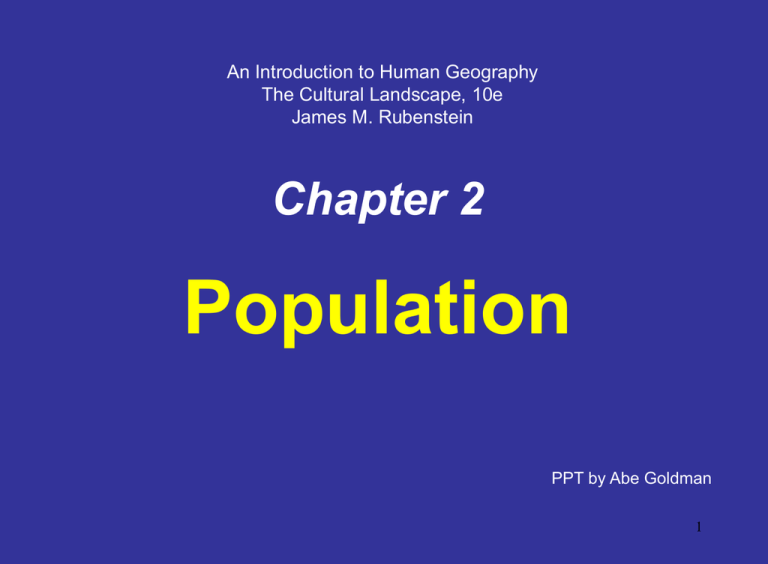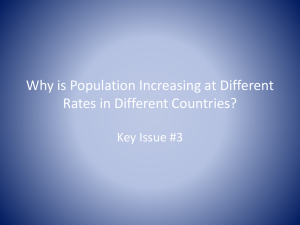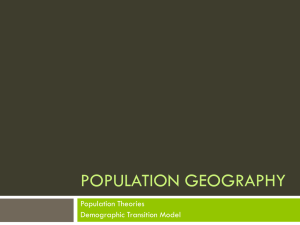
An Introduction to Human Geography
The Cultural Landscape, 10e
James M. Rubenstein
Chapter 2
Population
PPT by Abe Goldman
1
Distribution of World Population
• Population concentrations
– The four largest population clusters
– Other population clusters
• Sparsely populated regions
– Dry lands
– Wet lands
– Cold lands
– High lands
• Population density
– Arithmetic density
– Physiological density
– Agricultural density
2
AP HG Ch 2 notes: (INTRO)
• Why important to study pop.:
a) pop. = 6 ½ bill., more than ever before
b) increase rate in 2nd 1/2 of 20th cent. faster
than ever b4
c) *almost all of global pop. growth is in
LDC’s…where they have least resources
• demography: study of pop. characteristics:
how pop. is distributed spatially by age,
gender, fertility, health, occupation, etc.
• some problems = where is major pop. growth…
why it is growing at differ. rates in differ. places
• overpopulation: # people in certain area & the
ability of these people to have needed
resources to live decently
3
World Population Cartogram
This cartogram display countries by size of their population rather than
4
their land area. (Only countries with 50 million or more people are named.)
The Earth at Night…
http://antwrp.gsfc.nasa.gov/apod/image/0011/earthlights2_dmsp_big.jpg
5
KEY 1: Pop distribution basically =
concentration & density
Pop. Concentrations: 3/4 of people live on 5%
of Earth's surface -----remember 71% of surf.
= oceans, other areas are harsh
• 5 major concentr. = E. Asia, S. Asia, SE Asia,
W. Europe, Eastern N. Amer.
• similarities.: most near water, low-lying, fert.
soil, temperate (warm, but not hot)
• climate & all betw. 10º & 55º N lat. , except
for parts of SE Asia
-------------------------------------------------------------------------------------------------------
• Hectares: 10,000 sq meters or 2.47 acres6
1) East Asia #1 in pop. (China, Koreas, Japan,
Taiwan): 1/4 world pop. here
• China: #1 in pop., #3 in land area; most on river
valleys & coasts; 3/4 rural--most farmers
• Japan: most in Tokyo, Osaka…Korea: most in
Seoul
• 3/4 of Japan. & S. Kor. = urban
-most urban jobs in = industry or service
2) South Asia: #2 in pop.; (Pakistan, India,
Bangladesh, Sri Lanka)
--3/4 of this pop. in India
-most on coast or along Indus & Ganges Rivers;
7
1/4 cities most of pop. = rural farmers
World
Population
Distribution
World
population
is very
unevenly
distributed
across the
Earth’s
surface & it
can be
compared
to climate
distribution
.
8
3) SE Asia: #4 pop.; (Islands: Java, Sumatra, Borneo,
Pap. New Guinea, & Philippines, + Thailand, Vietnam,
etc.)
-Indonesia = 4th most pop. country;
--most are farmers in rural areas
• In these 3 Asian areas = over 50% of world’s pop. on
only 10% of world's land
4) Europe: #3 pop.; 75% in cities; less than 20%
farmers (many of farmers in S & E Eur.)
• Import most of food rather than produce
• This led to lots of colonization (Amer., India, China,
Africa, etc.) looking for resources & these resources
= lots of manufacturing
5) Eastern N. Amer.: #5; NE USA & SE Canada
• mostly urban… less than 5% = farmers
9
B) Sparsely pop. areas: too dry, wet, cold, high
Ecumene: areas that are permanently settled
--more were too harsh…innovations increase
ecumene
1) dry lands: 20% of Earth's surface; most in deserts:
Sahara,
Arabian, Gobi (N. Afr. SW & Centr. Asia)
growing desert = desertification
-little water for crops, etc., but many have oil
2) wet lands: too much rain; most = Equatorial rain
forests: excess rain + excess heat = poor
agricul….but can grow some rice
3) cold lands: area at & near N & S Poles; few plants &
animals
4) high lands: highest mtns. = steep, snow-covered
-exceptions: parts of Latin Amer. & Africa where
higher areas is better than lower hot/wet areas 10
Expansion
of the
Ecumene
5000
B.C.–A.D.
1900
The
ecumene, or
the portion of
The Earth w/
permanent
human
settlement,
has
expanded
to cover
most of the
world’s land
area.
11
C) Population density: look at it 3 ways… (Deja vu!!!)
1) arithmetic density (aka population density):
-# people per unit of land…USA = 30 per sq. km. (77/sq
mi)…but NY City (Manhattan) = 21,400/sq.km
(55,400/sq.mi.)
2) Physiological density: # people per unit of arable land:
is a more meaningful measure b/c can show pressure on
the land due to population
EX: Egypt: arithm. density = 70/sq.km; but
physiolg. density = 3,503/sq. km
3) agricultural density: ratio farmers to arable land
--lower agr. density = higher technology;
-MDC's: usually lower agri. density, & LDC’s usually
higher;
-in MDC’s, lots of land & few farmers means more pop. to
work in factories, etc.
12
Arithmetic Population Density
Fig. 2-4: Arithmetic
population density: # of ppl per total land
13
area. Highest densities found in parts of Asia & Eur.
Physiological Density
Fig. 2-5: Physiological
density is the number of people per arable land area.
This is a good measure of the relation between population and
14
agricultural resources in a society.
Distribution of World
Population Growth
• Natural Increase (NIR)
• Fertility (TFR)
• Mortality (IMR + MMR)
15
KEY 2: Where Has World's Pop. Increased?
Important terms: (NOTE: crude means "basic", i.e., not
specified by age, etc)
a) crude birth rate (CBR): # live births per 1,000 per
year:
CBR = 20 means for every 1000 in a place, were 20
births
b) crude death rate (CDR) # deaths in year per 1,000
c) natural increase rate (NIR): % by which a pop. grows
in a year…change CBR & CDR to %'s…
---------------------------------------------------------------------------------------------------------------------------------------------------------------------------------------------------------------------------------------------------------------------------
• To calculate NIR: CBR - CDR = _____?____
• then divide by 1000 to get NIR
EX: CBR = 25 CDR = 10
25 – 10 = 15 NI per 1000
------------------------------------------------------------------------------------------------------------------------------------------------------------------------------------------
Divide 15 by 1000 to get a % so it = 1.5% is NIR
16
CBR = 40
CDR = 28
NIR = .012 = 1.2%
World Population Growth
1950–2000
Fig. 2-6: Total world population increased from 2.5 to 6 billion in this half century. The
natural increase rate peaked in the early 1960s and has declined since, but the
17
number of people added each year did not peak until 1990.
Natural increase:
• Begin. of 21st cent., world NIR = 1.4; i.e., world
pop. is growing yearly by 1.4 %: now over 6.7
billion
--pop. growth is down somewhat (was 77
million in 2000; was 87 mil 1989)
-doubling time: # yrs. it will take for pop. to
double
--at 1.4%, our doubling time is now 51 yrs
-but in 1800 - 1950 to double…150 yrs.
As CBR goes up, doubling time goes down; CBR
down, dbl. time up; are inversely proportional
NIR is over 2.0% in most of Africa, Lat. Amer., &
Mid East (LDC’s…ones who can’t afford it) 18
Natural
Increase
Rates
**NIR is
negative in
Europe
…means
pop. is
declining if
you don't
count
immigrants
**Remember!
"N" =
"natural")
(NIR) = % of growth or decline in the pop. of a
country per year (not including net migration).
Countries in Africa & SW Asia have highest
current rates; Russia & some European
19
countries have negative rates.
Crude Birth Rates (CBR)
The crude birth rate (CBR) is the total # of births in a country per 1,000
20
population per year. Lowest rates: in Europe.
Highest rates: Africa & several Asian countries.
B) fertility: use CBR to study fertility; many subSaharan countries = CBR 40, but many Eurp. = less
than 10
-total fertility rate (TFR): avg. # of kids a woman will
have thru her child-bearing yrs (about 15-49)
-look at map (49) w/spatial association: shows
TFR
-TFR over 6 in some Sub-Saharan countries!
C) mortality: one important way to measure & look
at = CDR; another way is infant mortality rate
-IMR = of every 1,000 live births, # kids die b4 1
yr. old
-usually use per 1000, not %…but sometimes = %
-W. Eurp. = lowest IMR's (USA high for MDC)
-in some LDC's = 100…which means 10%
21
babies born alive die b4 1 yr. old
Total Fertility Rates (TFR)
The Total fertility rate (TFR) is the # of children an avg. woman
in a society will have thru her childbearing years.
Lowest rates: Europe. Highest: Africa & parts of22
Middle East.
Infant Mortality Rates (IMR)
The infant mortality rate: # of infant deaths per 1,000 live
23
births per year. Highest: found in some of the poorest
countries of Africa & Asia.
• IMR: strong indication of a country's health-care
system. Why? (When I ask you “why?”, etc., you
need to KNOW this!)
-though USA = MDC, IMR higher than Canada &
most Euro. countries….Why?
• life expectancy: calculated at kid’s birth…means
that child has a 50/50 chance of reaching a
particular age
-again, high in W. Eur. , low in sub-Saharan Afr.
-MDC's: lower CBR's, TFR's, & IMR's…but higher
life expectancy
-LDC's: high CBR, TFR, & IMR, but low life expect.
-CDR doesn’t have as wide a spread as CBR: 20 vs.
40 & LDC's actually bit lower than MDC's (p. 51)
24
-this contradiction due to demographic transition
Avg. Life Expectancy at birth
Life expectancy at birth: Avg. # of years a newborn infant can
expect to live. Highest: generally in the wealthiest25
countries. Lowest: in the poorest countries.
Crude Death Rates (CDR)
The crude death rate (CDR): total # of deaths in a country per
1,000 population per year. B/C wealthy countries are in
a late stage of the demographic transition, they often
26
have a higher CDR than poorer countries!!!!!
27
KEY 3: Demographic Transition:
Why pop. increases at differ. rates in differ.
places at differ. times
A) Demographic Transition: countries go thru 4
stages involving changes in CBR, CDR, & NIR
-every country at 1 stage or another…& it is
progressive: once go into a stage, you don't go
back… so far
Stage 1: low growth: hi CBR, hi CDR, NIR about
zero
-in earliest humans, most all = same stage; CBR
& CDR might vary from year to year, but hi on
avg.
-most all = hunter/gatherers for about 392,000 yrs.
28
1st agricultural revolution: 8,000 BCE:
happened in various places & pop. grew
faster
Agri-Revol.: When humans began to grow
foods & domesticate animals…
No longer move & scrounge as they had b/c
they had stable food sources
Still stayed basically at Stg 1 Low
growth…for about another 10,000 yrs.
-still problems w/ climate (famine), wars,
disease, etc
29
Stage 2: hi growth: hi CBR, lowering CDR, hi NIR
Stg 2 comes in 2 sections:
-2-a) pop. growth getting faster…….
-2-b) growth slowing, but CBR/CDR gap still hi
Innovation: a new idea or new way of doing
something; can be technology or can be
philosophical ideas
-1750: Britain was 1st to come into Stg. 2 b/c
was 1st w/ Industrial Revolution
Later spread thru W. Europe……then USA
30
Process of improv.:
a) indust. techn. (steam eng., mass
production, RR, later transportation
innovations)
b) brought wealth….which brought
health innova., sanitation, hygiene,
sewers, etc…= healthier… which
means…less disease
(Why did they improve these?)
c) + food production w/ less labor = laborers
for other jobs
…also health + food higher life expect.31
Other Eur. countries & USA didn’t hit Stg 2 til
about 1800
-Stg. 2 didn’t diffuse to most of Africa, Asia,
& Lat. Amer. til about 1950…& then world
pop. climbed!
*USA & Eur. moved to stg 2 b/c of industr./tech rev.,
BUT…others (Afr., Lat. Am., etc.) moved to
stg 2 b/c of medical revolution in mid-20th
cent.
This meant improved med. practices = less
diseases, less hardship = longer life &
healthier life…(rid of TB, malaria, smallpox,
32
etc.) = more having babies….
Stage 3: moderate growth: CBR, CDR both
lower
-CBR still higher than CDR, so pop. grow
but not so fast
-CDR dropping, but not as sharp as stg 2
-most Eur. & N. Amer countries from
stg 2 stg 3 in early 20th century…
--most Asian/Lat. Amer. recent
-but most African still in stg 2
Why do we move to stg 3?
B/C ppl choose to have _____?____ WHY?
33
a) more babies survive (lower ___? __)
b) less agric.--need less kids
c) more in cities…less “chores” use for kids
-when Child Labor laws cut out factory jobs, kids
no longer bring in $$..school required = more $$
d) urban homes = less avg. space = crowded
Stage 4: Low growth: CBR about = CDR
--NIR approaching 0 = ZPG
--ZPG can happen even if CBR bit higher
than CDR: b/c some girls won’t reach fertil.:
-so 2.1 TFR can = ZPG, unless lots of
immigrants
--most W. European countries in stg 4 &
well below 2.1 TFR’s
34
The Demographic Transition Model
The demogra. trans. in 4 stages:
-1st hi B & D 2nd -- then D rates declines
3rd -then in B rates decline
4th --then low B & D rates. BUT pop. highest in Stg
4
35
Pop. growth is most rapid in the 2nd stage.
• D-T Model w/ explanations, details…\Remember that
D-T model looks at GROWTH rate (NIR) more than
total population.
36
--in USA, not quite at stg 4 b/c of
diversity of pop.
-Lat-Americans & Af-Americans have
higher TFR’s; but Eur-Amer. tend to
have TFR’s more like Euro.
--social customs also enter in ? of stages…
EX: families on farms: mom stays home &
dad works at home & they have more
kids…hands to work chores
-as more women go to work & as families
more in urban areas, have less kids
37
Some E. Eur. countries have negative NIR b/c CDR
higher than CBR…this is 1 of results of old
communist system
1) CDR there result of hi pollution (few controls)
2) CBR result of strong fam.-planning…&
3) pessimism… (Why bring kids to this?)
-may change later…but if not could have a Stg 5…
Note: a) at begin. of Stg 1, CBR & CDR both high
(about 35- 40 per 1,000
--at Stg 4, both low (+ - 10/1000)
b) BUT…total pop. in Stg 4 much higher
38
than it is in Stg 1
England= good EX: of demog. trans. & stages:
WHY? Has good info for last 1000 yrs (kept records early), stable
history & boundaries, & not lots of migration earlier to affect
pop.
Stg 1) low growth til 1750: b4 this pop. up & down... (Black
Death dropped pop. in 1300’s, famine, etc.)
Stg 2) hi growth: 1750-1880: CBR still hi, but CDR lowering
-techn. innova. = more food, more $$$ invested in
health…..stayed stg. 2 about 125 yrs
Stg 3) Mod. Growth: 1880-early 1970’s
-sharp CBR drop from 33 to 15; CDR fell some…19 to 12
Stg 4: Lo growth: early ‘70’s to now:
--CBR betwn. 12-14 & CDR betwn 10-12
Engl. pop. grown about 1 mill. since 1970, BUT mainly thru
immigration…NOT natural increase
39
Demographic Transition in England
England was one of the first countries to experience rapid
population growth in the mid-eighteenth century, when
40
it entered stage 2 of the demographic transition.
Note that in England CBR & CDR dropped from
about 40 to about 12
(stg. 1 stg.4)
--but pop. up from 6 mill. (stg.1) to 50 mil (stg4)
B) Population pyramids: use age & gender to show
pop. w/in 5 yr. age groupings
(youngest = 0 – 4yrs at pyramid base)
-gives info RE: M vs. F & groups that might have
specific needs or indications…
Pyramid Shape comes mainly from the CBR of
the community
Stg. 2 country: Hi CBR w/ lot of kids so wide base
Stg. 4: larger older pop., wider top
41
1) age distribution: age structure of pop. is
important
-dependency ratio: # of those too old or too
young to work, so they depend a lot on the other
part of the pop.
-divide pop. in 3 sections…0-14, 15-64, 65- & older
-about 1/3 under 15 in Stg. 2, LDC’s
In stg. 4 countries, only about 1/3 = dependent
-only about 1/5 under 15 in those MDC’s at or
near stg 4
-large % of kid pop. = strain on resources for
schools, health care, daycare, etc.
42
% of Pop. under 15 (part of the ___?__ ratio)
About 1/3 of world population is under 15, but the % by
country varies: Most of Africa + some Asian: Over 40%
Much of Europe: Under 20%
43
In stg 4, ppl 65+ are larger % than in stg. 2 b/c longer
life expectancy (see p. 58…lower rt. fig.)
-in Europe over 65 = > 15%, but sub-Sahr.Africa = < 2%
-is called the “graying” of the pop. (Eur. & N.Am.)
-this can make CDR of stg 3 & 4 countries higher
than stg 2
2) sex ratio: # of males per 100 females w/in pop.
-more males born than females…but males have
higher death rates
-Eur. & N. Amer, sex ratio = 95:100; rest of world =
102:100
-in US, M vs. F under 15 yrs: 105:100
-at about 30, more F …& by 65, F = 60% of pop.
-migration affects sex ratio: males more likely to
migrate, so if hi immigration rates, usually more
males
44
1) View pyramids on p. 63…make notations
about shapes & why they have a specific
shape
2) Study the 3 examples of countries in various
stages of transi. Make notes about WHY
each has the shape it has…
45
Population Pyramids in U.S. Cities
Fig. 2-16: Population pyramids can vary greatly, with different fertility rates (Laredo vs.
Honolulu), or among military bases (Unalaska), college towns (Lawrence), and
46
retirement communities (Naples).
Copy items below & answer:
a) Cape Verde: Stg 2 hi growth…
--possible reasons why?
--major problems?
b) Chile: Stg 3: moderate growth…
--poss. reason why?
--major problems?
c) Denmark: Stg 4 low growth:
--poss. reasons why?
--major problems?
47
Rapid Growth in Cape Verde
Fig. 2-17: Cape Verde, which entered stage 2 of the demographic transition in about
1950, is experiencing rapid population growth. Its population history reflects
the impacts of famines and out-migration.
48
Moderate Growth in Chile
Fig. 2-18: Chile entered stage 2 of the demographic transition in the 1930s, and it
entered stage 3 in the 1960s.
49
Low Growth in Denmark
Fig. 2-19: Denmark has been in stage 4 of the demographic transition since the
1970s, with little population growth since then. Its population pyramid
shows increasing numbers of elderly and few children.
50
One is the EU, one Asia, one a retirement community
51
52
D) Demographic trans. & world pop. growth (p. 62)
2nd half of 20th century world pop. zoomed b/c few
countries were in the 2 stgs. w/ slower pop growth
which are what?? (___ & ____
Most were into 2nd (hi) or 3rd (moderate)
Some seem stuck in 2nd…maybe 3rd….
To move to 3rd or 4th need 2 big "break-aways" from
the past…
1. Techn. innovations
2. Changing social customs that allow for drop in CBR
-almost all are getting the techn. innov. (agric.,
medicine, etc.) that brings the drop in CDR
--but many slow to alter customs that keep CBR high
--resist situations that foster birth control measures
-keeps many from moving to Stg. 3… & then to 4th 53
Major difference betwn. Eur. & N-Amer. & those now in Stg.2:
Eur & N. Am. went thru Indust. Rev. on way to 3rd or 4th
so…econ. changes 1st more $$$ more improvements
social changes stg 3 ….then 4
Today's LDC's: Stg. 2 came from outside investment…
…little/no investment of their own
Good EX: Sri Lanka: from 1946 to 1947, CDR dropped 43%
b/c internat. organizations supplied them w/ DDT
(insecticide)
-sent DDT… trained S-L ppl to spray for mosquitoes …
…reduced malaria deaths
CDR dropped…but no econ. advances
-had MORE ppl…no more $$ or technol. revolutions
So…same economy & customs….but w/ hi CBR (& less
dying) …so way more ppl…w/o jobs
54
Eur. & N. Amer.:
Took about 100+ yrs to go from stg 2 3
Today's LDC's:
Tough to get to stgs. 3 or 4 w/o the time Eur/N. Amer had
to devel. & adjust
Many Asian + Lat. Amer. LDC's now have moved to stg 3
….now have a declining pop. (EX: Chile)
But Africa has not made this break w/ the past &…hasn’t
moved forward…
WHY?? MANY reasons…involving…
-History
-Customs
-Disease
-Geography
-Women
-Climates
B/C of these…
Some African countries MAY become 1st to go BACK to
55
Stg. 1… which has never happened b4
K- 4: Why world may face overpopulation problems:
Thomas Malthus
English economist, 1798 theory said the world would run
out of food in the future due to several factors:
pop. was increasing faster than food production
predicted a great famine about 100 yrs from then (1798)
his theory: pop. increases geometrically (X) but food
production increases arithmetically (+) So….
…1 person to 1 food unit…2 to 2…4 to 3…8 to 4…16 to 5...
Engl. was in Stg 2 of demogr. trans. b/c of Industr. Rev.
-Malthus said ppl needed "moral restraint“ (??) to
control CBR…unless war, famine, diseases, or other
disasters increased CDR
56
In Malthus' day, MDC's had the increasing pop…not
LDC's as it is now…(LDC’s were still Stg. 1)
Later ppl didn't think about LDC's gaining from med.
techn., but not from wealth & that pop. would
snowball
Now have “Neo-Malthusians”…who say Malthus was
right …but missed part …
Say we’ll have shortages of clean air, water, suitable
farmland, food AND fuel resources
Said these would = civil violence & wars in future b/c
of conflict over resources
Though Africa has increased econ. devel., increased
pop. more, so econ. growth hasn’t helped
57
--worse off than 1-2 decades ago
Critics of Malthus: various arguments against his
ideas…
Engels said M.'s idea were capitalistic…
-said world has resources for all…but are
unequally distributed…& some use more than their
share
Others say pop. growth can stimulate food prod.:
Growth = more customers & encourages more
techno. growth
Others say Malthus is too pessimistic b/c he assumed
food supply is fixed…& doesn’t allow for the
principles of _?_:
-ppl choose to expand food & other resources
58
Last 50 yrs. have not supported Malthus’
ideas…b/c…
1) food prod. is up b/c of techn…grow more faster
-new techniques, new strains of rice, etc., = better
2) pop. growth increased, but food prod. grew faster
3) we do have problems w/ those who can't afford or
get access to food
-but these are distribution problems, not inability to
produce (which is the NEWER theory)
4) also Mal.'s predictions of global growth were off
-said by 2000 would be 10 billion but only 6.7 bill.
5) he didn’t foresee cultural, econ. & tech. changes
-didn't see the demogr. transition Stgs. 3 & 4 59
Food Population, 1950–2000Malthus vs. Actual Trends
Malthus:
Said pop.
would grow faster
than food
Production
But …
food production
expanded
faster than
pop. in the 2nd half
of the 20th century.
60
SO…How do we reduce NIR??
Even if Malthus was wrong about pop. situation there are areas
w/ these problems
Those in stg 2 (hi growth) can reduce 1 of 2 ways…
1) go back to stg 1: higher CDR more equal to CBR
2) move to stg 3 or 4 by lowering CBR to the CDR
1) Higher CDR: could come from spread of disease esp. AIDS
-95% of AIDS deaths are in LDC's!
Africa: more than 2 mill. per yr….esp. southern
-Botswana, Namibia, Zambia, & Zimbabwe:
-1/5 of all deaths there caused by AIDS…
-25% of pop. is infected
-CDR here rose in '90's from 13 to 21…
-life expect. dropped from 55 yrs. to 40 yrs.
Higher CDR could push Africa back to stg 1 Demog. trans.
61
Other diseases in other LDC's may lead to higher CDR
1/3 of kids’ deaths in most LDC's is from poor sanitation &
its results ..like dysentery (diarrhea = dehydration = death) & other
infections
Another 1/3 die from diseases MDC-kids don't get b/c of
immunizations: EX: measles, polio, TB, diphtheria, tetanus,etc
62
Tuberculosis Death Rates, 2000
TB death rate: an indicator of country’s ability to invest in health
63
care …It’s still 1 of the world’s largest infectious-disease killers.
HIV/AIDS Prevalence Rates, 2002
Highest HIV infection rates are in sub-Saharan Africa. India &
64 (%)
China have large numbers of cases, but lower infection rates
Epidemiological Transition: 4 stages:
Stage 1: Stage of pestilence & famine: nature’s way of
holding pop. in check (EX: Black Plague)
Stg 2: stg. of receding pandemics: #’s lessen, but still
in crowded areas
(EX: Cholera in large cities)
Stg. 3 & 4: steady decrease in infectious diseases
...but increase in chronic degenerative & human-created
diseases EX’s: cancers & cardiovascular-disease
(smoking, diet, pollution, etc.)…age related
Stg. 5? MAYBE.. return to infectious & parasitic disease?
3 reasons:
1-evolution of drug resistant microbes
2-poverty in LDC’s
65
3- Increased travel & exposure
So…1 way to adjust = higher CDR…not too nice ..A better way?
2) lower birth rates: v. few want to see pop. contained by
higher CDR… lowering CBR is better choice…
2 ways to lower CBR: Long-run method + short-run method
a) Long-run method: economic development alternative:
Changes in society…
Wealthier = more able to spend $$ on educat. & healthcare…promotes lower CBR
One key: women: women in school have more
opportunities & choices, better control of lives…dollarwise & reproductive-wise
Better health-care = lower IMR & women more likely to have
less kids cause know kids likely to survive
b) But in short run: Distribute of birth con. methods:
Putting resources into family planning methods in LDC's =
a quicker way to drop CBR
LDC’s demand for B-C is greater than the supply
-We need to get more out there quickly & cheaply 66
Bangladesh: W. using contraceptives: 1975: 6% ... 2000: 50%
Now in many LDC's 2/3 of W use bir. contr.
But in Africa (& parts of Asia) only about 1/4 use…
Why? Women: low status…little/no education or econ. control
-- W’s hi-status comes from hi # of kids
--Also gives M hi-status b/c shows virility & power
--Some cultures view birth control use against their religious
or political beliefs
Many religions disapprove of some or all B-C devices:
including some of these…. (usually fundamentalists of the relig..)
-Roman Catholics
-Muslims
-fundamentalist Protestants
-Hindus
Last 8 yrs.: US govt. has withheld $$ for all B-C in many LDC’s
b/c of a possibility of abortion…even if only for mother’s life,
etc. …Big political issue in US
Pres. Obama has overturned this policy already
Most experts agree controlling CBR is best way, but LDC's &
international family planning organizations have limited $$$
67
to make it a reality
Use of
Family
Planning
Both the
extent of
family
planning
use
& the
methods
used vary
widely by
country &
culture.
68
Crude Birth Rate Decline, 1981–2001
CBR’s declined in most countries between 1981 & 2001
69
(BUT…the # of births per year increased from 123 to 133 mill.).
Cholera
in
London,
1854
By mapping the
distribution of
cholera cases &
water pumps
in Soho, London,
Dr. John Snow
identified the
source
of the waterborne
epidemic.
70
SARS
Infections in
China, 2003
China had 85 %
of the world's
SARS cases in
2003.
In China, the
infection was
highly clustered
in Guangdong
Province,
Hong Kong,
& in Beijing.
71
Historical Pop. growth
72
NIR graph
73
Growth since Industrial Revolution & Projected thru 2050
74
75
Population
pyramid for
Williamsburg,
VA
WHY???
76
Get into groups: What can these pyramids tell you??
A
B-1, B-2, B-3
C-1,
C-2
77
78
79
80







